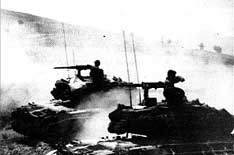On June 25, 1950, the Korean War began. The next day, Kim Il Sung declared: “The war which we are forced to wage is a just war for the unification and independence of the motherland and for freedom and democracy.” The three years of carnage that ensued would be known as the “Fatherland Liberation War.”
But, more than 50 years later, Pyongyang maintains it did not throw the first punch. The North, official policy says, simply responded when South Korean and U.S. forces crossed the 38th parallel on a campaign of conquest.
Regardless, North Korean forces easily overwhelmed their opposition. With 135,000 soldiers, the People’s Army of North Korea came equipped with about 150 tanks, including the acclaimed Soviet-made T34, plus mortar-equipped 120 mm howitzers, a good stock of machine guns, and an air force of about 180 Soviet-built planes. Nearly a third of the fighting force was made up of battle-hardened veterans of China’s recently ended civil war.
By comparison, South Korea’s force was not prepared for hard-core fighting. (The U.S., wary of Syngman Rhee’s unification desires, had restricted materiel and funding.) With no tanks, no heavy artillery, an air force of 22 unarmed or training planes, and an army of 95,000 troops, the Republic of Korea’s forces could not withstand the assault for long.
Nor did they. Within three days, North Korea had surged into Seoul and was on the verge of controlling the entire peninsula. Syngman Rhee, fleeing the South Korean capital to Taejon and then Pusan, desperately called for assistance. South Korea’s shattered army was barely holding onto Korea’s southern tip, Punan. With 90 percent of the rest of the peninsula under the control of the Korean People’s Army, it was all that stood between Kim Il Sung and his unification dream.
- Previous: 1945-1949 Background
- Next: June 1950 UN Responds




